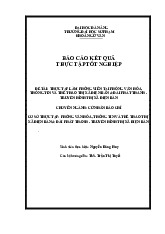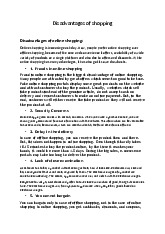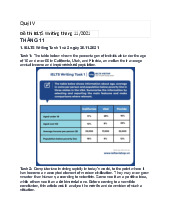



Preview text:
lOMoAR cPSD| 57855709 Going Bananas
The world's favourite fruit could disappear(bien mất) forever in 10 years’ time.
The banana is among the world's oldest crops đáp án c11 Agricultural scientists believe that
the first edible banana was discovered around ten thousand years ago đáp án c1. It has been
at an evolutionary standstill ever since it was first propagated in the jungles of South-East Asia
đáp án c2 at the end of the last ice age. Normally the wild banana, a giant jungle herb called
Musa acuminata, contains a mass of hard seeds that make the fruit virtually inedible. But now
and then, hunter-gatherers must have discovered rare mutant plants that produced seedless,
edible fruits. Geneticists now know that the vast majority of these soft-fruited plants resulted
from genetic accidents that gave their cells three copies of each chromosome instead of the
usual two. This imbalance prevents seeds and pollen from developing normally, rendering the
mutant plants sterile. And that is why some scientists believe the world’s most popular fruit
could be doomed. It lacks the genetic diversity to fight off pests and diseases that are invading
the banana plantations of Central America and the smallholdings of Africa and Asia alike.
In some ways, the banana today resembles the potato before blight brought famine to Ireland a
century and a half ago đáp án c3. But “it holds a lesson for other crops, too đáp án c10,” says
Emile Frison, top banana at the International Network for the Improvement of Banana and
Plantain in Montpellier, France. “The state of the banana,” Frison warns, “can teach a broader
lesson: the increasing standardisation of food crops around the world is threatening their ability to adapt and survive.”
The first Stone Age plant breeders cultivated these sterile freaks by replanting cuttings from
their stems. And the descendants of those original cuttings are the bananas we still eat today.
Each is a virtual clone, almost devoid of genetic diversity. And that uniformity makes it ripe for
diseases like no other crop on Earth. Traditional varieties of sexually reproducing crops have
always had a much broader genetic base, and the genes will recombine in new arrangements in
each generation. This gives them much greater flexibility in evolving responses to disease - and
far more genetic resources to draw on in the face of an attack. But that advantage is fading fast,
as growers increasingly plant the same few, high-yielding varieties. Plant breeders work
feverishly to maintain resistance in these
standardised crops. Should these efforts falter, crash. “When some pest or disease comes along,
yields of even the most productive crop could Geoff Hawtin , director of the Rome-based
swiftly severe epidemics can occur, đáp án c4” says International Plant Genetic Resources Institute.
The banana is an excellent case in point. Until the 1950s, one variety, the Gros Michel,
dominated the world’s commercial banana business đápn án c12. Found by French botanists in
Asia in the 1820s, the Gros Michel was by all accounts a fine banana, richer and sweeter than
today’s standard banana and without the latter’s bitter aftertaste when green. But it was
vulnerable to a soil fungus that produced a wilt known as Panama disease. “Once the fungus lOMoAR cPSD| 57855709
gets into the soil, it remains there for many years. There is nothing farmers can do. Even
chemical spraying won’t get rid of it đáp án c5,” says Rodomiro Ortiz, director of the
International Institute for Tropical Agriculture in Ibadan, Nigeria. So plantation owners played a
running game, abandoning infested fields and moving to “clean” land - until they ran out of
clean land in the 1950s and had to abandon the Gros Michel. Its successor, and still the reigning
commercial king, is the Cavendish banana, a 19th-century British discovery from southern
China. The Cavendish is resistant to Panama disease and, as a result, it literally saved the
international banana industry. During the 1960s, it replaced the Gros Michel on supermarket
shelves. If you buy a banana today, it is almost certainly a Cavendish. But even so, it is a minority in the world’s banana crop.
Half a billion people in Asia and Africa depend on bananas đáp án c13 Bananas provide the
largest source of calories and are eaten daily. Its name is synonymous with food. But the day of
reckoning may be coming for the Cavendish and its indigenous kin. Another fungal disease,
black Sigatoka, has become a global epidemic since its first appearance in Fiji in 1963. Left to
itself, black Sigatoka - which causes brown wounds on leaves and premature fruit ripening - cuts
fruit yields by 50 to 70 per cent and reduces the productive lifetime of banana plants from 30
years to as little as 2 or 3. Commercial growers keep black Sigatoka at bay by a massive chemical
assault. Forty sprayings of fungicide a year is typical. But despite the fungicides, diseases such as
black Sigatoka are getting more and
fungicide, they develop resistance, đáp án c7 ” says Frison mo
re difficult to control. “As soon as you bring in a new
. “One thing we can be sure of is
that black Sigatoka won't lose in this battle.” Poor farmers, who
cannot afford chemicals, have it “Most of the banana fields
even worse. They can do little more than watching their plants die. ,” says Luadir Gasparotto
in Amazonia have already been destroyed by the disease đáp án c8 ,
Brazil’s leading banana pathologist with the government research agency EMBRAPA. Production
is likely to fall by 70 per cent as the disease spreads, he predicts. The only option will be to find a new variety.
But how? Almost all edible varieties are susceptible to the diseases, so growers cannot simply
change to a different banana. With most crops, such a threat would unleash an army of
breeders, scouring the world for resistant relatives whose traits they can breed into commercial
varieties. Not so with the banana. Because all edible varieties are sterile, bringing in new genetic
traits to help cope with pests and diseases is nearly impossible. Nearly, but not totally. Very
rarely, a sterile banana will experience a genetic accident that allows an almost normal seed to
develop, giving breeders a tiny window for improvement. Breeders at the Honduran Foundation
of Agricultural Research have tried to exploit this to create disease-resistant varieties. Further lOMoAR cPSD| 57855709
back-crossing with wild bananas yielded a new seedless banana resistant to both black Sigatoka and Panama disease.
Neither Western supermarket consumers nor peasant growers like the new hybrid. Some accuse
it of tasting more like an apple than a banana. Not surprisingly, the majority of plant breeders
have till now turned their backs on the banana and got to work on easier plants. And
commercial banana companies are now washing their hands of the whole breeding effort,
preferring to fund a search for new fungicides instead. “We supported a breeding programme
for 40 years, but it wasn't able to develop an alternative to the Cavendish. It was very expensive
and we got nothing back đáp án c6,” says Ronald Romero, head of research at Chiquita, one of
the Big Three companies that dominate the international banana trade.
Last year, a global consortium of scientists led by Frison announced plans to sequence the
banana genome within five years. It would be the first edible fruit to be sequenced. Well,
almost edible. The group will actually be sequencing inedible wild bananas from East Asia
because many of these are resistant to black Sigatoka. If they can pinpoint the genes that help
these wild varieties to resist black Sigatoka, the protective genes could be introduced into
laboratory tissue cultures of cells from edible varieties. These could then be propagated into
new disease-resistant plants and passed on to farmers.
It sounds promising, but the big banana companies have, until now, refused to get involved in
GM research for fear of alienating their customers. “Biotechnology is extremely expensive and
there are serious questions about consumer acceptance đáp án c9,” says David McLaughlin,
Chiquita’s senior director for environmental affairs. With scant funding from the companies, the
banana genome researchers are focusing on the other end of the spectrum. Even if they can
identify the crucial genes, they will be a long way from developing new varieties that
smallholders will find suitable and affordable. But whatever biotechnology’s academic interest,
it is the only hope for the banana. Without it, banana production worldwide will head into a
tailspin. We may even see the extinction of the banana as both a lifesaver for hungry and
impoverished Africans and the most popular product on the world’s supermarket shelves Questions 1-3
Complete the sentences below with NO MORE THAN THREE WORDS from the passage for each answer.
Write your answers in boxes 1-3 on your answer sheet.
1. Banana was first eaten as a fruit by humans almost .....ten thousands...................... years ago.
2. Banana was first planted in ....... jungles....................
3. Wild banana’s taste is adversely affected by its .....potato...................... Questions 4-10 lOMoAR cPSD| 57855709
Look at the statements (Questions 4-10) and the list of people. Match each statement with the correct person A-F.
Write the correct letter A-F in boxes 4-10 on your answer sheet.
NB You may use any letter more than once.
4F. A pest invasion cuộc xâm lược của sâu bệnh may seriously damage banana industry.
5A. The effect of fungal infection nhiễm trùng nấm in soil is often long-lasting. 6D.
A commercial manufacturer gave up on breeding bananas for disease-resistant 7C.
Banana disease may develop resistance to chemical sprays.
8E. A banana disease has destroyed a large number of banana plantations.
9D. Consumers would not accept genetically altered crops.
10C. Lessons can be learned from bananas for other crops. List of People A. Rodomiro Ortiz B. David McLaughlin C. Emile Frison D. Ronald Romero
E. Luadir Gasparotto F. Geoff Hawtin Questions 11-13
Do the following statements agree with the information given in Reading Passage 31?
In boxes 11-13 on your answer sheet write
TRUE if the statement agrees with the information
FALSE if the statement contradicts the information
NOT GIVEN if there is no information on this
11. Banana is the oldest known fruit. True
12. Gros Michel is still being used as a commercial product. False
13. Banana is the main food in some countries. True



